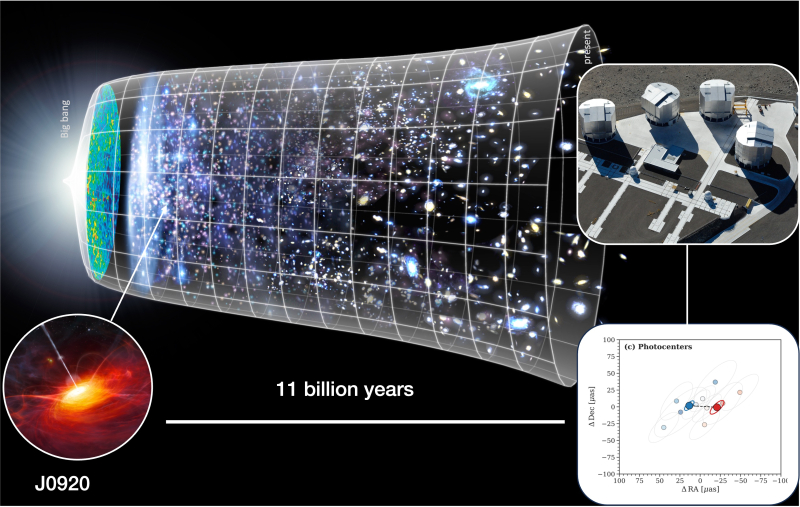Follow us on Google News (click on ☆)

This illustration of the Universe's expansion features our black hole's host galaxy at the bottom left and the spectro-astrometric signature that allowed GRAVITY+ on the VLTI (to the right) to measure the mass of this black hole at the bottom right.
© Original composition: T. Shimizu; "Universe expansion" image: NASA/WMAP team; quasar illustration: ESO/ M. Kornmesser; VLTI interferometer: ESO/G. Hüdepohl.
The question of the co-evolution of galaxies and the black holes at their core is central to understanding these objects, but the mechanisms at play are poorly understood. The main diagnostic relies on comparing the growth of the central black hole and the host galaxy. Therefore, a direct measurement of black hole masses at different cosmic ages is crucial for monitoring and analyzing this co-evolution.
We know the mass of the central black hole in our Galaxy thanks to the GRAVITY instrument and the measurement of the trajectories of stars very close to it. This same instrument has also measured the masses of a few black holes in relatively nearby Quasars. The challenge was to extend this technique to the distant Universe to cover a wide range of cosmic ages and especially the peak of Galaxy formation about 2 billion years after the Big Bang, around 10 billion years ago.
This is the main goal of the GRAVITY+ project, an expansion of the VLTI and GRAVITY's capabilities, undertaken by an international team involving CNRS Earth & Universe.
Using GRAVITY+, the team has managed to directly measure the mass of a black hole in the early phases of the Universe's evolution for the first time, just 2 billion years after the Big Bang, corresponding to the time when galaxies began to structure themselves (the "Cosmic Noon").
This black hole, located at the center of galaxy SDSS J092034.17+065718.0, has a measured mass of 300 million times that of our Sun. This immense mass is yet more than ten times lower than what the prevailing black hole - galaxy coevolution model predicted. This initial result, paving the way for many more, thus opens the door to a profound revision of galaxy formation mechanisms and all that they entail.
Reference:
Abuter, R., Allouche, F., Amorim, A. et al.
A dynamical measure of the black hole mass in a quasar 11 billion years ago.
Nature (2024).